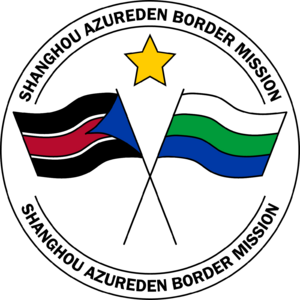Sekidean Union: Difference between revisions
No edit summary |
No edit summary |
||
| Line 53: | Line 53: | ||
|}}}}}} | |}}}}}} | ||
|common_name = Sekidaea | |common_name = Sekidaea | ||
|image_flag = [[File: | |image_flag = [[File:SUFlag{{SekideaunUnionMembersActual}}Stars.png|border|125px]] | ||
|flag_caption = [[Flag of the Sekidean Union|Flag]]<!--{{collapsible list | |flag_caption = [[Flag of the Sekidean Union|Flag]]<!--{{collapsible list | ||
|expand_list=true | |expand_list=true | ||
Revision as of 08:54, 17 August 2022
Sekidean Union
| |||||||||||||||||||||||||||||||||||||||||||||||||||||||||||||||||||||||||||||||
|---|---|---|---|---|---|---|---|---|---|---|---|---|---|---|---|---|---|---|---|---|---|---|---|---|---|---|---|---|---|---|---|---|---|---|---|---|---|---|---|---|---|---|---|---|---|---|---|---|---|---|---|---|---|---|---|---|---|---|---|---|---|---|---|---|---|---|---|---|---|---|---|---|---|---|---|---|---|---|---|
| Anthem: For the nations, strong together (ISU anthem) | |||||||||||||||||||||||||||||||||||||||||||||||||||||||||||||||||||||||||||||||
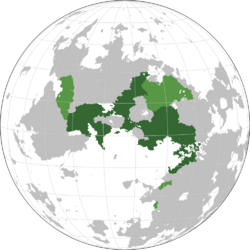 | |||||||||||||||||||||||||||||||||||||||||||||||||||||||||||||||||||||||||||||||
| Largest city | Canton | ||||||||||||||||||||||||||||||||||||||||||||||||||||||||||||||||||||||||||||||
| Demonym(s) | Sekidean | ||||||||||||||||||||||||||||||||||||||||||||||||||||||||||||||||||||||||||||||
| Legislature | Sekidean Cabinet of Leaders | ||||||||||||||||||||||||||||||||||||||||||||||||||||||||||||||||||||||||||||||
| History | |||||||||||||||||||||||||||||||||||||||||||||||||||||||||||||||||||||||||||||||
• Shanghou Pact established | 3 March 1957 | ||||||||||||||||||||||||||||||||||||||||||||||||||||||||||||||||||||||||||||||
• Sekidean Union established | 1 January 1983 | ||||||||||||||||||||||||||||||||||||||||||||||||||||||||||||||||||||||||||||||
• Inner Union established | 1 January 2012 | ||||||||||||||||||||||||||||||||||||||||||||||||||||||||||||||||||||||||||||||
• Water (%) | 5 | ||||||||||||||||||||||||||||||||||||||||||||||||||||||||||||||||||||||||||||||
| HDI (2019) | very high | ||||||||||||||||||||||||||||||||||||||||||||||||||||||||||||||||||||||||||||||
| Currency | Sekinar (ISU) (SEK) Multiple local | ||||||||||||||||||||||||||||||||||||||||||||||||||||||||||||||||||||||||||||||
| Time zone | UTC-8; -7; -6; -5; -41/2; -4; -3 | ||||||||||||||||||||||||||||||||||||||||||||||||||||||||||||||||||||||||||||||
• Summer (DST) | not observed | ||||||||||||||||||||||||||||||||||||||||||||||||||||||||||||||||||||||||||||||
Sekidean Union is a miltiary and economic organization in Anteria that separetes itself into Inner and Outer Unions, which associates a total of [[Template:SekideaunUnionMembers|Template:SekideaunUnionMembers countries]]. It cooperates closely with Dokodo Union via the Kasian Council and with the Norterric Assembly via an association treaty. It was formed by a unionisation of Shanghou Pact and Purple Community into one union (although the two unions technically exist to this day and are politically frozen).
Division
The Sekidean Union is consisting of a [[Template:SekideaunUnionMembers|total of Template:SekideaunUnionMembers countries]], however, due to multiple federal agreements and past decisions, in the Sekidean Treaty System, there are total of 20 independent entities.
Those entities are:
17
All-Union rules
| Agreement of the merger of Shanghou Pact and Purple Community into Sekidean Union | |
|---|---|
| Presented | 23 June 1982 |
| Ratified | 14 November 1982 |
| Date effective | 1 January 1983 |
| Location | Gimyeong, Prei Meas |
| Author(s) | Ulman Чuчlik, former Zhoushi president |
| Signatories | |
| Media type | International Document |
| Purpose | Better stability in the region |
Following text includes obligatory rules to all SU countries as they were signed:
Agreement of the merger of Shanghou Pact and Purple Community into Sekidean Union
- Obligation to defend other member if he is attacked
- Free trade agreement
- No customs or border tariffs
- Obligation to remain neutral or pro-government if a civil war or a coup d'etat begins in a member country
- Right to vote in the pact manners
- Obligation to treat other pact member's citizens or respective minorities that are a majority or a plurality in other member country or have their home territory in other member country kindly, meaning no directed harassment or violence and offer them right to ask for a court in their home country or the country having a majority of their ethnicity in if the country is in the alliance
- Members shall recognize our joint history and culture and work together to protect our joint heritage
- We shall vote together on issues concerning culture and mineral extraction and trade
- Every member country gets a right to make polls for others to vote, majority/plurality/unanimous vote requirements to be set in a further agreements (to be determined on a further summit requiring an unanimous vote to enact)
- Every Member is allowed to move through the Canton Canal and the Colonia-Pinžak with Military Ships, for this Canton is allowed to charge toll on the Canton Canal and the Committee formed by Gadorien, Zhousheng and Monte Blanco on the Colonia-Pinžak Canal
- Members agree to protect only the mainland or the heart territory of each state, colonies remaining unprotected by the pact as their position doesn't apply to the original Pact conditions
- If a new member asks to join, an unanimous vote is required. To apply, a country must be bordering an existing pact member or have a reasonable naval connection that can not be easily disrupted by a foreign non-pact military power in the region
In 2002, text was amended with a second section considering rather functionality than purpose of the union:
Functionality amendment
- Countries get right to join a free movement union
- Neither SHANGHOU PACT or PURPLE COMMUNITY have dissolved, but contain only the former member of the founding alliances, newcomers are members of neither
- Both members and founders are member of the supranational entity – the SEKIDEAN UNION
- All joining countries agree to give up their right to vote after 3 days of the vote, meaning that if new vote is declared on the 1st of October at 5:37 PM GMT, all countries which have not cast their vote before 4th of October at 5:37 PM GMT officially agree to abstain from voting, meaning that votes are concluded as if the non-participating country had voted neutrally
- Countries agree to develop military assets using a standardized calibre for each type of weapon with the exception for armament for special forces
- For opening of the SU-lead negotiations, more than 50% of the SU members must agree for it
- Joining the SU must be proceeded with a unanimous (no negatives) vote and a negotiation that can be opened with official application for membership
- To change the founding charter unanimous (no negatives) vote must be required with at least 75% of people voting in favour of the edit
- SU mission must have at least 50% of the SU members voting in favour before it is approved
- Country can be kicked from the Sekidean Union if at least 65% of votes on the kicking vote are for the proposal (and negative votes work like negative positives and are subtracted from the percentage)
- On other votes, ≥50% of votes must be AYE for the vote to pass, but NAY serves as a negative aye, meaning that if there are 4 ayes and 2 nays, it is just like if there were just 2 ayes
New members and their approval
New member can either by invited or ask to join the union. Although not being a official requirement, the veto power allows member countries to set more unofficial requirements. Such as in the case of Velharia, democracy had been upheld as a necessity to join the Sekidean Union. With the development of the SU into a large organization, several other factors came to be, such as candidates are required to prove economical stability and edit their trade agreements to allign with those of the Sekidean Union. Those unofficial expectations have been summed up as:
- No irredentism
- No expansionism
- No excessive interventionism
- No excessive nationalism
- Stable economy (economic growth, no excessive inflation)
- Democratic or at minimum semi-democratic political system
- No discrimination against a group of people (such as a particular nation, race, gender, orientation...)
- Rule of law and equality before the law
- Capitalist system (no fully planned economies)
- Protection from brutal and/or unusual punishments
- Right for a free speech for every citizen
- Stable geopolitical situation (such as no direct wars and no excessive hostilities)
Kentalian entry
Entry of Kentalis was highly controversial, as country was separeted by a body of water from otherwise compact Union. The vote was one of the most controversial and the eventual entry proved to be a good decision in the long run for the Union and Kentalis alike.
Bak entry
Bakyern was approved only with a entry agreement in their fourth entry attempt, first and second being vetoed by Gadorien and third being vetoed by Prei Meas. Only the Vescarium crisis pushed all SU countries to ensure their sovereignity by letting Bakyern join the Union.
Krenyan entry
Krenya was approved on their third attempt, first being vetoed by Zhousheng and second being vetoed by Gadorien. The country's entry was originally controversial because of the long-lasting dictatorial regime. However, after required reforms were done, Krenya was let to join the Union.
Current members
| Nation: | Admission Date: | Status: | Former union: | Notes: | |
|---|---|---|---|---|---|
| 26 September 2000 | ACTIVE | Anterian Defense Alliance | Admitted during Vescarium Nuclear Crisis | ||
| 1 January 2018 | ACTIVE | Unaffiliated | This entry secured the position of SU on the seas | ||
| 11 May 2005 | ACTIVE | Unaffiliated | Main supporter of future Kistolia entry | ||
| Founding Member | ACTIVE | Purple Community | Most populous member | ||
| 1 July 2021 | ACTIVE | Unaffiliated | |||
| Founding Member | ACTIVE | Shanghou Pact | Gadorien is the only country that ever invoked the defense clause | ||
| Founding Member | ACTIVE | Purple Community | Country has long been the only one not having territory in Thuadia | ||
| 5 June 2008 | ACTIVE | Unaffiliated | |||
| 1 January 2003 | ACTIVE | Unaffiliated | Country's entry was controversial because of lack of shared border | ||
| 1 January 2006 | ACTIVE | Unaffiliated | Kistolia's entry was controversial because of the problematic relations with Acriae | ||
| 31 December 2020 | ACTIVE | Unaffiliated | A duchy that reformed from centuries of absolute rule | ||
| 1 March 2021 | ACTIVE | Unaffiliated | Country's entry was a strong symbol after the conclusion of the Lisvonyan Wars | ||
| Founding Member Created Mustelaria in 2017 |
ACTIVE | Shanghou Pact | Although being part of Mustelaria, in SU country operates independently | ||
| 3 October 2003 | ACTIVE | Unaffiliated | The first SU country to practice (partially) modern federalism, spreading the idea to other countries. | ||
| Founding Member | ACTIVE | Purple Community | Shanghou Pact | Only country that was member of both Purple Community and Shanghou Pact | |
| 1 October 2000 | ACTIVE | Unaffiliated | |||
| 9 November 2003 | ACTIVE | Unaffiliated | Isolationist country maintaining most severed relations with SU HQ | ||
| 31 December 2020 | ACTIVE | Unaffiliated | Joined along with Krenya to settle the border dispute | ||
| 11 May 2005 | ACTIVE | Unaffiliated | Country's entry was the first entry to not be preceded by diplomatic discussion | ||
| Founding Member Created Mustelaria in 2017 |
ACTIVE | Shanghou Pact | Although being part of Mustelaria, in SU country operates independently | ||
FOUNDING - 2000's - 2010's - 2020's
Refused entries
Main article: Velharian War
| Velharian War | |||||||
|---|---|---|---|---|---|---|---|
 Zhoushi fighters above Southern Velharia | |||||||
| |||||||
| Belligerents | |||||||
|
|
| ||||||
| Strength | |||||||
|
65,000 Troops 30,000 Rebels | ~20,000 Troops | ||||||
| Casualties and losses | |||||||
| ~150 KIA; ~500 wounded | ~250 KIA | ||||||
Only country that was refused to join was Velharia, which was under absolute monarchy and after their hyperinflation and economic collapse of early 2000's was tied to a monetary support from Zhousheng and Gadorien. The entry vote was held in 2011 and was vetoed by Zhousheng and Gadorien, which expected eventual integration of Velharia into the Sekidean Union after their economy recovers.
Tensions between the country and Sekidean Union started rising after Velharia briefly leased Ateenia a naval base and allowed deployment of nuclear weapons on their territory, although Sekidean politicians managed to salvage the crisis by paying Ateenia to cancel the lease.
Although no official declaration of war was recieved, Velharia siezed Zhoushi and Gadori assets and construction sites in Velharia and invaded a strip of land that was sold to Gadorien few months ago. In response, 1st clause was enacted for the first time and Gadorieni and Zhoushi troops entered Velharia. Velharian populace rose in revolt against the monarch and Velharia was overrun by Sekidean troops in 72 hours.
After the war, Velharia was placed under Sekidean military administration and was integrated into Gadori civil administration in 2013. In 2018, local autonomy was declared, called the Duchy of Velharia.
Foreign missions
Current missions
Currently, Sekidean Union is participating in 2 foreign missions:
 Azureden - SU controlled a 100km wide strip of land on Preimeai border as a buffer zone for 3 years. Currently Preimeai, Mustelarian and Gadori forces operate directly against the Coalition and support the Azurites.
Azureden - SU controlled a 100km wide strip of land on Preimeai border as a buffer zone for 3 years. Currently Preimeai, Mustelarian and Gadori forces operate directly against the Coalition and support the Azurites.
Pan-Sekidean Organs
Sekidean Cabinet of Leaders
Sekidean Cabinet of Leaders is a unofficial name for the regular breefings by leaders of all Sekidean Countries and activities, in which every country gets one vote and which leads to the maintenance of the Sekidean Union as a unified organization.
Voting
TBA
Sekidean Treaty Court
Sekidean Treaty court is the only Union institution, that has a jurisdiction over all Sekidean members, not just the Inner Union. Its role is to uphold and enforce the following of the Sekidean Charter by SU member countries and punish any violation of the treaty, be it by a fine or by a legal challenge. This organ is based in Palača Bogov, Torvon
Former Unions
Shanghou Pact
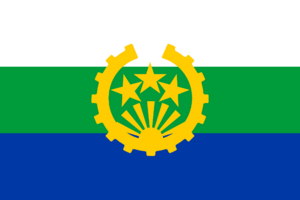 Organization flag | |
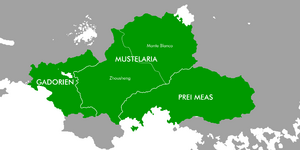 Location of the Union
| |
| Summary: | |
|---|---|
| Currency: | Sekinar (today) Former currencies:
|
| Established: | 3 March 1957 |
| Military HQ: | Pōr Ōntōra, Prei Meas[a] |
| Shanghou Commander: | Jan Чaŋriчna |
| Members: | |
| Official language: | |
| Minority languages: | |
| |
Shanghou Pact, created as a result of a military alliance between Zhoushi Union (of Bogmia and Zhengia) and Gadorien after the War of the Council, including Monte Blanco as a next member in 1969 during the outbreak of the Preimeai civil war and Prei Meas itself after the civil war ended by involvement of the Shanghou Pact.
History of Shanghou missions
Although not officially existing as a military alliance, a unofficial link between Gadorien, Bogmia and Zhengia was formed during the War of the Council. After the defeat of the Council State in 1942, the two countries settled the boundary by exchanging multiple territories, which created multiple autonomies. During the next few years, Zhengia and Bogmia unified into Zhousheng and international trade became more and more important to both countries. Because of that, in 1957, Shanghou Pact was created as a military pact with economical side benefits between Zhousheng and Gadorien, having its first official military HQ in Tropponz, Grad Autonomy, Zhousheng.
The first country to join the newly formed allience was Monte Blanco, which, being threatened by an unstable situation on its southern border, decided to seek support by other countries with the same situation. With communists in Prei Meas winning one victory after another, Shanghou countries realized, that they have a hostile power on their shared boundary. In early 1970's, multiple military raids on Zhoushi-leased ports by communist forces lead to the enactment of the mutual defence clause. The retalitory strikes, followed by Shanghou Military intervention, obliterated forward defences of Preimeai communists, quickly pushing them behind the defendable perimeters and reinstating the Nokor. After the civil war ended, Prei Meas joined as a next member of the Shanghou Pact. Shortly after, the HQ was moved to Pōr Ōntōra, Phnom Autonomy, Prei Meas.
In late 1970's, Velharia tried to join on multiple occasions, claiming their position as reasonable on membership. Although having some reasonable arguments for their membership, Velharian regime was absolute monarchy autocratic, giving fear to the Shanghou politicians of possible dictatorial authoritarian precedent between other monarchist communities across the region (such as Krenya).
After Prei Meas joined the Purple Community, Shanghou countries decided to start talks on unification of the two organizations into one (which later came to be as the Sekidean Union). In 1989, representatives of the six countries (Gadorien, Zhousheng and Monte Blanco representing the Shanghou Pact, Canton River Delta and Great Golden Raj representing the Purple Community and Prei Meas acting as a mediator) and drafted a treaty based on combination of obligations form both Purple Community and Shanghou Pact that later came to be as the Sekidean Charter.
Although countries now being in the Sekidean Union, both organizations continued to maintain basic functions. The clause about reasonable threat, which was not included in the Sekidean Charter, was triggered by Prei Meas in 2006 at the outbreak of the Azure civil war, leading to SP countries taking a 100km wide stripe on the Azureden-Preimeai border, creaing a functional buffer zone between the chaos of the civil war and the Sekidean Union.
Although not officially, the Pact effectively ceased to exist in 2011 with the creation of the Inner Circle, which took over the functions of the Pact. To this day, every month, the rent on the miltary HQ base in Pōr Ōntōra is paid by the ISU fund, being maintained as one of backup headquarters for the Sekidean Armed Forces.
Treaty of the Shanghou River
| Treaty of the Shanghou River | |
|---|---|
| Presented | 7 January 1957 |
| Ratified | 2 March 1957 |
| Date effective | 3 March 1957 |
| Location | Confluence of Shangou River and Kandan Canal, Zhousheng |
| Author(s) | Borey Chea, former Zhoushi president & ethnic Zaprei |
| Signatories |
|
| Media type | International Document |
| Purpose | Creation of a military alliance |
Following text is a text signed by the countries joining the Shanghou Alliance, be it as a founder or as a new member:
Treaty of the Shanghou River
1. Countries signing the treaty are obligated to join defensive wars of other countries as far as they are in the dedicated area (via map inset)
2. Countries signing the treaty can demand their defense if they feel threatened
3. Countries agree to share partially-merged international politics
4. Countries agree to respect national minorities of other national countries
5. If there is a coup or a civil war in one of the countries, other countries are obligated not to join in support of the rebel forces
6. Common military practice is to be held at least once in a five year period
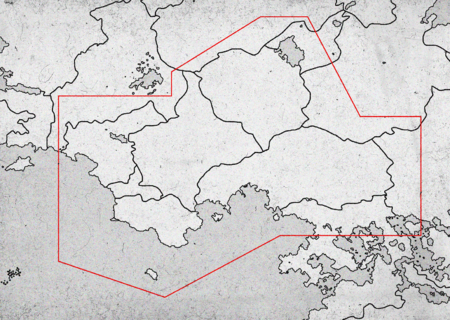
Map included in the accession agreement of Prei Meas into Shanghou
Those rules served as a base for the future creation of the Sekidean Charter.
Purple Community
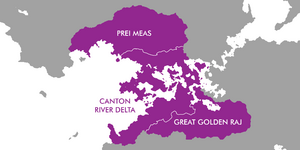 Location of the Union
| |
| Summary: | |
|---|---|
| Currency: | Sekinar (today) Former currencies:
|
| Established: | 8 February 1982 |
| Cultural seat: | Canton City, Canton River Delta |
| Official language: | Member state languages: |
| Minority languages: | |
Purple Community is the younger of the two predecessors to the Sekidean Union. It, unlike the Shanghou Pact, was dedicated for cultural and political cooperation rather than military buildup and security purpouses. From the Purple Community was contributed the idea of joint history (via article 7 of the Sekidean Charter), trade benefits and trade synchronisation (articles 2, 3 and 8). Main income of the Purple Community quickly became the Canton Canal, a canal located in Canton River Delta, which, along with Cerisium Canal in Azureden, is needed to travel from the Hagalaz Ocean into the Sunadic Ocean through the narrow point between Thuadia and Thrismari. The benefit of the canal was later codified by the clause about demilitarization and tolls (article 10).
